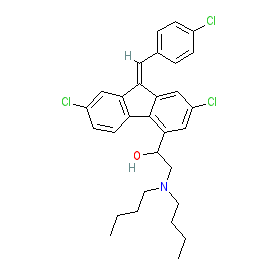GtoPdb is requesting financial support from commercial users. Please see our sustainability page for more information.
|
Synonyms: benflumetol
lumefantrine is an approved drug (FDA (2009) in combination with artemether)
Compound class:
Synthetic organic
Comment: Lumefantrine belongs to the aryl amino alcohols, a chemical class of antimalarial compounds that includes quinine, mefloquine and halofantrine.
Lumefantrine is a racemic mixture, with PubChem listing 9 stereoisotopes. The Malaria tab on this ligand page provides additional curator comments of relevance to the Guide to MALARIA PHARMACOLOGY. |
|
|||||||||||||||||||||||||||||||||||
| Guide to Malaria Pharmacology Comments |
| Lumefantrine was first synthesized in the 1970s in China by the Academy of Military Medical Sciences as part of Project 523, an initiative to identify new antimalarial drugs [2]. The compound has activity against the asexual blood stages of P. falciparum and is used to treat malaria as part of an artemisinin-based combination therapy (ACT). Lumefantrine is on the World Health Organisation's List of Essential Medicines. Click here to access the pdf version of the WHO's 21st Essential Medicines list (2019). Potential Target/Mechanism Of Action: As the precise mechanism of action of lumefantrine is not yet known, we do not have a molecular target for this compound. Further information about possible mechanistic insights is provided under the Clinical data tab. |









